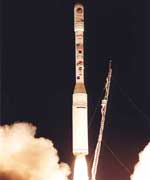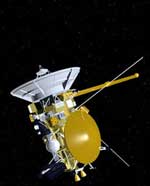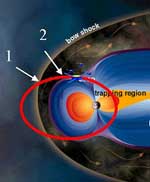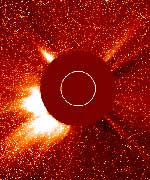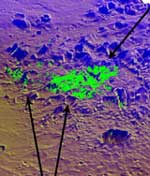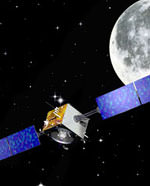The aurora reports are in. Universe Today readers from around the world have kept their eyes to the sky over the last few days and seen some of the best auroras in several decades. In the Northern Hemisphere, I’ve heard reports from as far south as Florida and Texas, while people in Australia and New Zealand have been treated to a show as well. It looks like Northern Europe, especially Scotland had some of the best auroras – for two straight evenings.
Here are some emails I received over the last day from people lucky enough to see the auroras. Did you spot them? Send me an email at [email protected] and I’ll post your comments. Send in any pictures in JPEG format.
In Edgecome Maine we had a unique display which was predominately bright red, at times like the sky was painted with red paint. It all came from a very specific point directly over head. The brightest color was between 7:30 and 8pm and lasted until about 9pm or a little later. This was the best I’ve seen them in this area ever. – Caleb, Edgecome, Maine
I was lucky enough to see an aurora on Wednesday night at around 21.30 (gmt) it was along the northern horizon and was pale green in colour.It extended up to about the height of Ursa Major this was the first time i had seen a aurora from this location in England since the 1980s. My observing co-ordinates are 52.560″N 0.109W. – Martin, England
Last night around 7 PM I hopped outside and was awed… very similar to the time I saw the aurora back in 1991. Almost the entire northern horizon was vertical bands of white, slowing moving and changing shape. Moving up away from the horizon, the color changed to red and at some points the very faint bands were actually nearly directly overhead, slowly progressing and fading out. – Mark, Pennsylvania, USA
Well, I discovered today that you don?t have to travel very north to see some Northern Lights. As an Ohioan, I have been waiting my entire life to come across these magnificent light shows, and tonight my wish came true. My fianc? and I have been planning to travel to Alaska or Canada to see these aurora, but we didn?t have to go very far tonight. We were just sitting on the porch passing out candy for the Halloween Trick-or-Treaters here in Elyria, Ohio (near Cleveland) and we saw a beautiful cloud of red in the sky. I gasped and said, ?Look! Do you know what that is???? My fianc? replied, ?No. It?s not an aurora, honey. It?s just some smoke from a fire.? Even though I had never seen one in my life, I knew exactly what it was. The streams of color got brighter and more distinct as it drew higher and higher in the sky. The pattern of lights was moving slowly, and they hung in the atmosphere for quite a while? I?m guessing about 20 minutes. My mother was with us, so she took some pictures while the passers-by looked at me like I was crazy (Imagine a girl dressed as Cleopatra standing motionless in the middle of the driveway staring at the sky). We just have to get the pictures developed; I can?t wait! I?m not expecting much from them, though. We did not have a tripod, and the exposures were fairly long. But the experience was unexplainable. I will never forget this Halloween year! – Lindsey, Ohio
We saw red streams in the sky similar to the shape of an umbrella overhead with a centre core, it appeared wine/red and white colour stripes shifting as we watched. It was an amazing site to see the reddish glow. – Sandra, Prince Edward Island, Canada
I saw green spires below Polaris, and then huge blue/white pillars of light moving in waves directly through Cassiopeia and across into Andromeda. Fantasy clouds of glowing red continued to appear and disappear covering these northeastern constellations. Stretching laterally through Auriga, the pure blue/green “wave” of aurora caught and held. Holding out my shaking hands, I realized this was roughly 20 degrees in length and fluctuated anywhere from 5 to 10 degrees in width. I watched amazed as the ribband seemed to undulate in colors – running anywhere from a pale cyan to a vivid orange. The soft white pillars, like distant searchlights, continued to alternate sky positions from the northeastern horizon up to the zenith. Soft red “clouds” were appearing in patches here and there… But I couldn’t stop staring at the ribband. Sparing a look behind me, I saw that the clouds were fast returning from the southwest and I realized I was on borrowed time. I enjoyed a solid 20 minutes of incredible auroral activity. – Tammy, Ohio
Early Tuesday morning, I saw the red glow in the sky above some clouds that were closer to the horizon. If there was any green below the red, it was obscured by the clouds. I saw it at around 3:15 CST in Imperial, Missouri, just south of St. Louis, Missouri. The coloring was similar to that in your picture (below), but not quite as vivid here. – Theresa, Missouri, USA
We had an awesome display last night (the 29th) in Akron Ohio (app 41 degrees North). We had about a 2 hour clear window until 9:30 or so. Bright red/pink at the horizon with occasional pink/reddish blobs toward the zenith. Rarely there were the typical greenish rays flickering, but that was not a constant sight in our moderately light polluted area. The maximum color was around 7:30-8:00, EST. – Tom, Ohio, USA
I work at the Mills Observatory in Dundee which is the only full time public observatory in the UK and we got a fantastic view of the aurora last night. It was the brightest aurora I have ever seen – Robert, Scotland
I was flying from Toronto to Ottawa last night around 8:30pm and saw them from the aircraft. Luckily I was on the side if the plane that was facing north. They were green, but very, very bright. I could see the wing clearly by the aurora light. I thing the rest of the people on the plane must of thought I was nuts though. I was sitting looking out the window with my jacket hood over my head to block the internal lights… I suspect I was the only person (apart from the pilots) on the plane that saw them. – Andrew, Ontario, Canada
So there I am, thinking “I’ll just take a peek at the night sky before going to bed”. On any other night I would have been out with the telescope but I’d been playing football and wanted to go to bed! Looking to the south I saw Orion, Taurus, and those other wonderful winter constellations letting me know that my serious astronomy for the year was about to begin. Looking north I saw a hazy light that I immediately attributed to hazy cloud. Something rang a bell in my mind though, someone said “What was it that Universe Today article said?”. And so I allowed my eyes to become accustomed to the dark and observed the Northern Lights! Shimmering waves of light like waterfalls glowed gently in the sky, occasionally flaring up and flashing in places as they slowly shifted and danced around Ursa Major, Ursa Minor, Draco and all those so familiar northern constellations. To see them bathed in that wonderful glow, for the first time since I started looking at the sky 20 years ago, made me grateful to Nature (for the terrific show), Science (for the understanding of what I was looking at) and to Universe Today, without which I would have dismissed them as merely hazy cloud without a second thought. – Stefan, York, England
Humungous aurora over central Scotland this evening. First saw it about 19.00 UT and it’s still continuing unabated (23.30 UT). Conditions are far from ideal with a lot of high, thin cloud and a fair bit of thicker cloud here and there. Nevertheless we had everything – pulsing patches; rays; streamers; curtains and several coronas (coronae?). The whole sky was involved, with a lot of the best action being to the South. About 50 people were watching it from the Mills Observatory in Dundee, and were totally bowled over by the experience. Unfortunately, being really busy with visitors we didn’t get the opportunity to take any pics (sigh!) but what a night! This is far and away the best, longest aurora I’ve witnessed in my 50-odd years interest in astronomy. – Bill, Dundee, Scotland
Just thought I would report a wonderful aurora I saw this morning here in Australia,I am at 33degrees south and I was up from 2:30 am to 4:30 am looking south I saw white shafts of bright light extending 90 degrees above my head,these lights changed positions constantly, no red or green colours were seen. – Leon, Australia
After the powerful CME solar event of 29 October 2003, I observed an aurora between 2am-3.30am (local daylight savings time) from Wollongong, New South Wales, Australia on 30 October 2003. It was not very bright, although digital photographs showed an intense red below turning to blue on the higher sections. You could see the red colour faintly with the unaided eye. The aurora consisted of slow moving “searchlight beams” that travelled west to east, over the horizon at the South Celestial Pole in a slow consistent fashion, sometimes fading in and out. There was an overall reddish haze too. Mostly the beams were faint but distinct and quite tall (about 40 degrees in height) reaching as high as the top of Crux, the Southern Cross, apart from a small number of beams that increased in brightness at 3am for 5 minutes. It was still a beautiful sight and 90 minutes is quite a long period to view such an event considering the relatively high latitude of 35 deg. S. – Christian, Wollongong, Australia
Thought I’d drop a line to say that tonight I have seen the Aurora at 8pm(GMT) which was long ribbons of light bands extending East to West but rippling from North to South. Some were coloured greenish but most were mainly white. It looked spectacular against the clear sky, almost like someone waving a searchlight around the sky. – Russ, Dundee, Scotland
Yes, I did see the Aurora Borealis here tonight! Here is the island ?meland in the north of the Netherlands. Between aprox. 22.15hrs. and 23.30hrs.(local time,ofcourse, GMT +1) the sky turned ruby-red with delicate pale-yellow bands and strings.We have seen the Aurora many times ,but we never saw such an intense red.At the end of tonights show the whole of the nothern horizon looked as a midsummer-nightsky,when the sun hardly dissapears. It was great to watch. – Ingrid, The Netherlands
